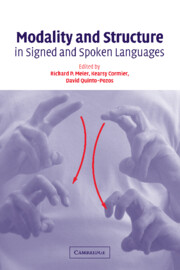Book contents
- Frontmatter
- Contents
- List of figures
- List of tables
- List of contributors
- Acknowledgements
- 1 Why different, why the same? Explaining effects and non-effects of modality upon linguistic structure in sign and speech
- Part I Phonological structure in signed languages
- Part II Gesture and iconicity in sign and speech
- Part III Syntax in sign: Few or no effects of modality
- Part IV Using space and describing space: Pronouns, classifiers, and verb agreement
- Index
Part I - Phonological structure in signed languages
Published online by Cambridge University Press: 22 September 2009
- Frontmatter
- Contents
- List of figures
- List of tables
- List of contributors
- Acknowledgements
- 1 Why different, why the same? Explaining effects and non-effects of modality upon linguistic structure in sign and speech
- Part I Phonological structure in signed languages
- Part II Gesture and iconicity in sign and speech
- Part III Syntax in sign: Few or no effects of modality
- Part IV Using space and describing space: Pronouns, classifiers, and verb agreement
- Index
Summary
At first glance, a general linguistic audience may be surprised to find a phonology section in a book that focuses on sign language research. The very word “phonology” connotes a field of study having to do with sound (phon). Sign languages, however, are obviously not made up of sounds. Instead, the phonetic building blocks of sign languages are derived from movements and postures of the hands and arms. Although early sign researchers acknowledged these obvious differences between signed and spoken languages by referring to the systematic articulatory patterns found within sign language as “cherology” (Stokoe 1960; Stokoe, Casterline, and Croneberg 1965), later researchers adopted the more widely used term “phonology” to emphasize the underlying similarity. Although different on the surface, both sign and speech are composed of minimal units that create meaningful distinctions (i.e. phonemes, in spoken languages) and these units are subject to language specific patterns (for discussions of phonological units and patterns in American Sign Language [ASL], see Stokoe 1960; Stokoe, Casterline, and Croneberg 1965; Klima and Bellugi 1979; Liddell 1984; Liddell and Johnson 1986, 1989; Wilbur 1987; Brentari 1990; Corina and Sandler 1993; Perlmutter 1993; Sandler 1993; Corina 1996; Brentari 1998).
The research reported in this set of chapters contributes to our understanding of sign phonology, and specifically to the issue of whether and how the way in which a language is produced and perceived may influence its underlying phonological structure.
- Type
- Chapter
- Information
- Modality and Structure in Signed and Spoken Languages , pp. 27 - 34Publisher: Cambridge University PressPrint publication year: 2002



